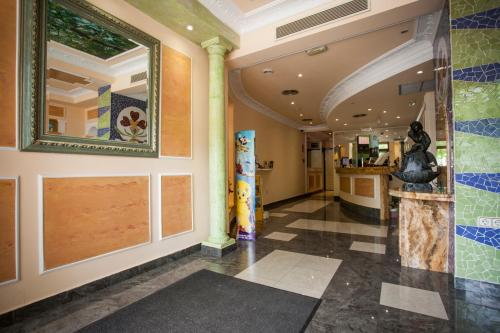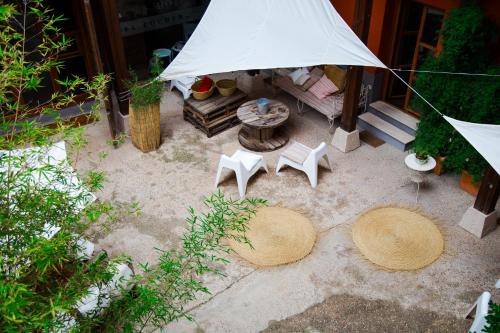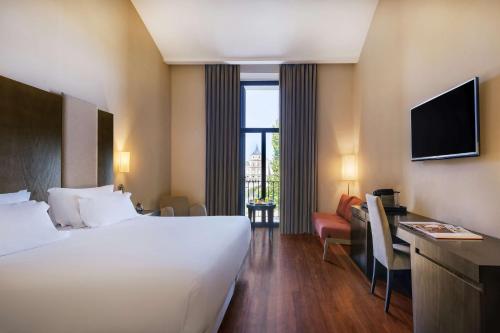The seasons have long been important for the Spanish Royal Family. It makes sense when you consider the extremes between different times of the year and different parts of the country.
The season can have a huge effect on a lot of things… your general disposition being one of those things, and that shouldn’t be quickly discounted.
And so it was for many centuries that the Spanish royals simply moved their court (and hence the seat of government) four times a year to different locations that were best suited for the particular season.
In springtime, the court moved to Aranjuez and it’s here that we find the magnificent Royal Palace of Aranjuez still standing.
Built initially as a hunting lodge in the 16th century, it’s grown into a glorious residence full of beautiful rooms that each seem like a piece of art.
And the large grounds that were once used for hunting have been landscaped into several gardens set alongside the branches of the Tagus River.
Why is Aranjuez Royal Palace important?
The palace at Aranjuez is one of the most important buildings in the country because it has been an official residence of the Spanish Royal Family since the 16th century.
The Aranjuez Royal Palace has been listed as a World Heritage Site primarily because of its series of parklands that have incorporated natural landscapes into its designs.
Who lives in the Royal Palace of Aranjuez?
The Royal Palace of Aranjuez is still a country residence of the Spanish Royal Family, meaning the King of Spain and his family could stay here. However, nobody from the Royal Family lives here permanently.
Can you visit Aranjuez Royal Palace?
Yes, the Aranjuez Royal Palace is open to the public and you can visit many of the main rooms. The gardens of Aranjuez Palace are also open to visitors.
With quick and easy access from Madrid, visiting the Aranjuez Royal Palace is a breeze. But, just as the Spanish Royal Family came here for centuries to escape the bustle of the capital, you may like to consider taking it easy as well.
I think it’s worth staying overnight, which allows you to explore not just the palace, but the extended cultural landscape of Aranjuez that has been named as one of Spain’s World Heritage Sites.
There’s lots to see inside the palace, which is why I would recommend this guided tour (with an entrance fee included).
The imposing facade of Aranjuez Palace, based on Italian styles, hasn’t changed much in recent years, and the building certainly feels like a reflection of Spain’s previous position as a global power, rather than a modern residence.
Yet, because Aranjuez was renovated and expanded many times over its history, it’s actually a collection of many different styles, spanning centuries and presenting the various ways the Spanish kings ruled their domain.
History of the Royal Palace of Aranjuez
Aranjuez Royal Palace was established in the 16th century under King Philip II, although the site had already been in use by the royals for almost a hundred years as a hunting ground.
Philip II was the first champion of Aranjuez and had a dream to create a great Italian-inspired villa, commissioning the famous architect Juan Bautista de Toledo to design the tree-lined streets around it.
But, when Philip II died, construction was abandoned for almost a century.
Thankfully there were more champions waiting to take his place, particularly King Philip V, who restarted construction in 1700 with a plan to make it rival the Palace of Versailles.
After a devastating fire, King Ferdinand VI rebuilt Aranjuez in a late Baroque style. And it was King Charles III who put the finishing touches on the palace in the late 1700s and made it how we see it today.
(An interesting bit of trivia – Charles III was also the king who built Caserta Palace at Naples, a much larger and grander royal residence.)
Through some of the 1800s, the Spanish Royal Family continued to visit Aranjuez during the spring season, making it the seat of government.
It was also the scene for important historical events such as the wedding of King Charles IV in 1765, the signing of the Treaty of Aranjuez in 1777, and the abdication of King Ferdinand VII in 1808.
The Royal Palace of Aranjuez was first opened as a museum in 1931, although it remains one of the official residences of the King of Spain.
Things to see at Aranjuez Royal Palace
Aranjuez Royal Palace has been well preserved and what you see today when you go inside is incredible.
The rooms are decorated in such luxurious detail, each with its own style, it feels as though you are in an art gallery where you walk through centuries of royal vogues.
Unfortunately, I can’t show you any of that because the Royal Palace of Aranjuez has a silly rule that prohibits photography (one of my pet peeves).
But let me tell you about the highlights you’ll see when you visit Aranjuez Royal Palace.
- The Porcelain Room (Cuarto del Porcelana): This opulent chamber is known for its exquisite porcelain decorations. Commissioned during the reign of Charles III, it features intricately crafted porcelain tiles, furniture, and delicate chinaware. The room’s striking blue and white color scheme, adorned with floral motifs, showcases the artistic and technological prowess of the era.
- The Hall of Mirrors (Salón de los Espejos): Inspired by the Hall of Mirrors at the Palace of Versailles, this grand hall is a masterpiece of Baroque design. Lined with mirrored walls and adorned with crystal chandeliers, it was often used for formal receptions and ceremonies. The room’s reflection and illumination create a sense of spaciousness and grandeur.
- The Prince’s Room (Sala del Príncipe): This chamber was originally designed for the future King Ferdinand VII. Its neoclassical style features sumptuous furnishings, including a luxurious canopy bed. The room offers a glimpse into the life and tastes of Spanish royalty in the early 19th century.
- The Throne Room (Salón del Trono): A space of immense historical significance, this room served as the backdrop for royal proclamations and ceremonies. It features a magnificent throne, rich tapestries, and ornate decorations that emphasize the power and authority of the Spanish monarchy.
If you’ve been to a few other royal palaces in Europe, you’ll probably find the layout quite familiar.
The large grander rooms that were used for events or meetings are closer to the entrance, as you go further back, the rooms become more private, with both the king and the queen having a series of their own spaces.
In that sense, what you’ll find in the interior of Aranjuez Palace is not particularly different from others of the period. Where it does stand out, is in the gardens.
The Royal Gardens of Aranjuez
Thankfully I can show you photos of the gardens of Aranjuez Palace, which is perhaps a bit of a blessing in disguise.
These landscaped areas don’t often get the same attention as the building but they are quite remarkable and are one of the main reasons why the Aranjuez Palace has been named a World Heritage Site, while most of the other Spanish royal sites haven’t been.
There are three main gardens attached to the palace and each has its own distinct style.
The Parterre Garden
Directly to the east of the main palace building – at what is considered the rear these days – is the Parterre Garden. It’s the most manicured of the three and has carefully arranged flowerbeds, short hedge boxes, smooth statues, curving paths and large beautiful fountains.
The Parterre Garden is not large and does not take long to walk through. It was always designed to be private and intimate.
The Island Garden
Connected by a small bridge over a canal, just to the north of the main palace building, is the Island Garden. It does technically sit on an island created by two diverging flows of the Tagus River but you don’t get that impression when you’re in it.
The Island Garden is large, with the main axis more than 500 metres long. Taller hedges and trees with thick collections of leaves mean you can never see too far in any direction.
Even the main paths through the garden are interrupted by wonderful fountains – not large but detailed and meaningful.
The Prince’s Garden
The largest of the three gardens – by a long way – is the Prince’s Garden, to the east of the palace. The perimeter of the garden is about seven kilometres long and the whole area is about 150 hectares.
It’s a sprawling space and hard to see all of it on the one visit. The Chinese Pond stands out as a highlight, as does the number of large fountains. The tree-lined avenues create a sense of wild grandeur in the garden.
If you walk far enough through the Prince’s Garden, you’ll eventually hit the Casa del Labrador, a lodge amongst the trees.
It’s large by the standards of any normal guesthouse but small compared to the main Aranjuez Palace. Inside, it is beautifully decorated with fine items gathered from around the world and precious Spanish artworks.
It was built by Charles IV, the son of Charles III who took the time and care to complete the main palace. Charles IV loved Aranjuez but he also wanted it to feel like a home, not just like an official royal residence.
This is why he built this lodge out in the garden – somewhere to escape with his family and friends. Somewhere he would feel comfortable.
It’s the same reason this land was first used by the royals as a hunting ground, and not too dissimilar to why a palace was built here for use in the spring.
It’s about making the most of the seasons, of nature, of the atmospheres that can turn royal life into something more pleasant.
Visiting Aranjuez Royal Palace
It’s very easy to get to Aranjuez from Madrid, with a direct train taking you right to the centre of town, from where you can explore other parts of the city and walk to the Royal Palace.
Inside the Aranjuez Palace, it takes about 90 minutes to go through the rooms and have a look at all the details.
To see the gardens, you may want a few hours – particularly for the large Prince’s Garden.
It’s why I think you may want to stay overnight, so you’re not rushed. Or, at the very least, plan for a full day in Aranjuez.
A few other bits of information for a visit to Aranjuez Palace:
- The gardens open at 8:30 each morning and close between 18:30 and 21:30, depending on when sunset is.
- For accessibility, there are access points for people with reduced mobility and manual wheelchairs at the Royal Palace and the Museum of Royal Barges.
- La Casa del Labrador is temporarily closed
Where is the Royal Palace of Aranjuez?
The Royal Palace of Aranjuez is found along the Tagus River in the centre of Aranjuez, about 55 km south of Madrid.
It’s located at Pl. de Parejas, s/n, 28300 Aranjuez, Madrid, Spain. You can find it on a map here.
How do you get to the Royal Palace of Aranjuez?
To get to Aranjuez from Madrid, catch the C-3 train from Atocha. From Aranjuez station, it’s a 20-minute walk to the palace.
By car, it will take just under an hour to drive from Madrid to Aranjuez. There’s an underground parking lot in front of the palace entrance.
When is the Royal Palace of Aranjuez open?
The Royal Palace of Aranjuez is open throughout the year during the following times:
April to September: Tuesday – Sunday from 10:00 – 19:00 (access until 18:00)
October to March: Tuesday – Sunday from 10:00 – 18:00 (access until 17:00)
The palace is closed on Mondays
What is the Royal Palace of Aranjuez entrance fee?
Entrance to the Royal Palace of Aranjuez costs:
€9 for a standard ticket and €4 for a concession. Children under 5 are free,
On Wednesday and Sunday, there is free entry from 15:00 until 19:00 for EU and Latin-American citizens.
There’s free entry to the Island Garden and the Prince’s Garden.
Are there tours to the Royal Palace of Aranjuez?
The palace does offer an audio guide for €5 that is decent and will give you a lot of information. But for even more local insight, I recommend this guided tour of the palace.
Another great experience is this hot air balloon ride over the city and the palace.
For more information, see the official website of The Royal Palace of Aranjuez.
The city itself has quite a few things to see because this is a community that was formed to support the Royal Court and the other workings of the palace.
I recommend seeing the royal church, heritage hospital, and bullring, which all show the opulence of a community that grew to serve the Spanish kings and queens.
For places to eat in Aranjuez, there’s a lovely restaurant called Restaurante El Parterre, or if you’re looking for more of a bar, there’s Pub La Belle Fusión.
THE BEST ACCOMMODATION IN ARANJUEZ
Although it’s not far from Madrid, staying in Aranjuez will give you time to explore the city beyond the palace.
BACKPACKER

There aren’t any hostels in Aranjuez, but Hostal Castilla is one of the cheapest options in town.
BUDGET

You’ll get good value at Hotel Jardín de Aranjuez, with large rooms in a central location.
BOUTIQUE

There’s a beautiful touch of Spanish architecture at El Cocheron 1919, with its design blending rustic and modern elements.
LUXURY

Not only is NH Collection Palacio de Aranjuez the nicest in town, it’s got a great view of the palace!
Love the new post! Loook awesome garden in your post. Lovely pics. Thanks!
Wow! what a place to visit, I want to meander in these gardens and want to take some photographs to share on social media accounts.
Thanks for sharing this beautiful information about this beautiful park, glad to read it and I would like to explore this city soon.
Great, Royal garden is looking so amazing and very well designed garden. it is full with beautiful things and great photos you shared.
thank you so much for awesome blog Enjoyed reading this. Your pictures are great.
Great, that is an amazing place and its design is so charming. Garden is looking more beautiful and its well design garden. Great photos you shared of that garden.
Interesting historical facts of the Royal palaces, the images are attractive, thanks for the wonderful post.